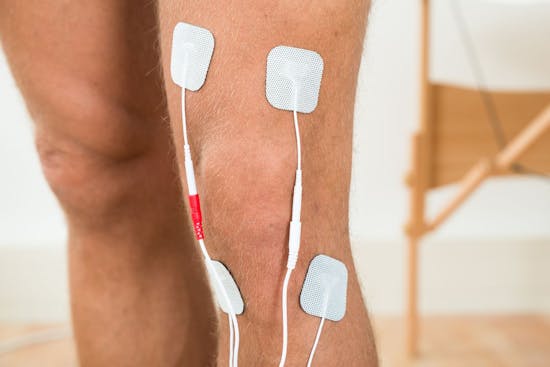
Electrical stimulation (E-stim) is a physical therapy treatment involving the application of electrical stimulation to treat neurogenic pain (caused by nerves), myofascial pain (pain in muscle trigger points), and inflammatory conditions. It is typically part of a complete rehabilitation program that involves patient education, exercise, manual therapy, and a home program.
Why E-stim?
The body has a continual flow of resonating electrical impulses that transmit signals through living tissues, utilizing electrons, chemicals, and electromagnetic bonds. The body's tissues are lined with water-hydrated matrices that act as semiconductors to permit the transfer of electrons and communicate specific frequencies. Each cell, tissue, and organ has its own specific frequency that synchronizes its activity within the body. Electrical stimulation is aligned to support the intricate biological and physiological phenomenon that has been exhibited throughout electrotherapeutics in clinical history - electricity will take the path of least resistance as it flows through tissue.
What is an electrical stimulation treatment like?
Electrical stimulation therapy is a passive treatment administered over multiple sessions. You sit with the electrodes placed in the appropriate locations as determine by your therapist. In some cases, patients may be asked to contract your muscles during an E-stim treatment session.
If you are experiencing pain, spasm, inflammation, or muscular weakness, your physical therapist may use E-stim as part of your physical therapy treatment plan.
What conditions respond well to electrical stimulation?
The following are some of the conditions that respond well to E-stim.
- Low back pain
- Post-surgical pain
- Muscle weakness
- Poor motor control
- Muscle spasms
- Tendonitis
- Bursitis
- Peripheral Neuropathy
- Myofascial Pain Syndrome
- Chronic musculoskeletal pain
Types of Electrical Stimulation
- Transcutaneous Electrical Neuromuscular Stimulation (TENS) - for the management of acute and chronic pain
- Iontophoresis - used to help administer medication through your skin and into your body
- Neuromuscular Electrical Stimulation (NMES) - uses an electrical current to cause a single muscle or a group of muscles to contract (muscle recruitment)
- Russian Stimulation - also used for muscle recruitment, but uses a different waveform that may be a little more comfortable for some patients
- Interferential Current (IFC) - used to decrease pain, decrease muscular spasm, or improve localized blood flow to various muscles or tissues
- High Voltage Galvanic Current (HVGC) - high voltage and low-frequency electricity that penetrates deep into tissues to improve blood flow, relieve muscle spasm, and improve joint mobility
Contact us to find out how E-stim can help relieve your chronic pain and help restore muscle function.
